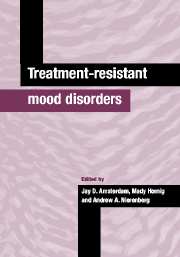Book contents
- Frontmatter
- Contents
- List of contributors
- Preface
- Part I The clinical problem
- Part II Biological basis
- 3 Psychoneuroendocrine aspects of treatment-resistant mood disorders
- 4 Estrogen and depressive illness in women
- 5 Sleep abnormalities in treatment-resistant mood disorders
- 6 Structural and functional brain imaging in treatment-resistant depression
- 7 Immunologic factors in treatment-resistant depression
- Part III Treatment approaches
- Part IV Special patient populations
- Part V Economic and ethical issues
- Index
- Plate Section
4 - Estrogen and depressive illness in women
from Part II - Biological basis
Published online by Cambridge University Press: 25 March 2010
- Frontmatter
- Contents
- List of contributors
- Preface
- Part I The clinical problem
- Part II Biological basis
- 3 Psychoneuroendocrine aspects of treatment-resistant mood disorders
- 4 Estrogen and depressive illness in women
- 5 Sleep abnormalities in treatment-resistant mood disorders
- 6 Structural and functional brain imaging in treatment-resistant depression
- 7 Immunologic factors in treatment-resistant depression
- Part III Treatment approaches
- Part IV Special patient populations
- Part V Economic and ethical issues
- Index
- Plate Section
Summary
One of the most consistent findings in the epidemiology of mental disorders is the higher prevalence of depressive illness in women than in men. Several recent national and international studies have confirmed the increased prevalence of depression in women including the Epidemiologic Catchment Area Study (Regier et al., 1988), the National Comorbidity Study (Kessler et al., 1993) and others (Paykel, 1991; Weissman et al., 1993; Weissman & Klerman, 1977; Wittchen et al., 1972). In these studies, the prevalence of depressive illness among women is approximately 1.5 to 3 times that among men. Moreover, it has been established that this sex difference in the prevalence of depression is not due to genetic transmission of the disorder (Merikangas et al., 1985), to sex differences in help-seeking behavior (Dohrenwend & Dohrenwend, 1977), to experience and reaction to stressful life events (Kessler et al., 1979), or to differential exposure to the factors related to depression (Radloff & Rai, 1979). Nor is the sex difference in the prevalence of depressive illness attributable to the tendency for physicians to detect more psychiatric illness in women than in men (MacIntyre & Oldman, 1977).
In the face of a sex difference in the prevalence of any medical disorder, investigating the possible influence of the sex steroid hormones in its pathogenesis is frequently a sensible and useful strategy. It is clear that some women are at greater risk for the development of a depressive episode subsequent to a change in their circulating levels of the sex steroids during various reproductive events.
Keywords
- Type
- Chapter
- Information
- Treatment-Resistant Mood Disorders , pp. 80 - 95Publisher: Cambridge University PressPrint publication year: 2001



